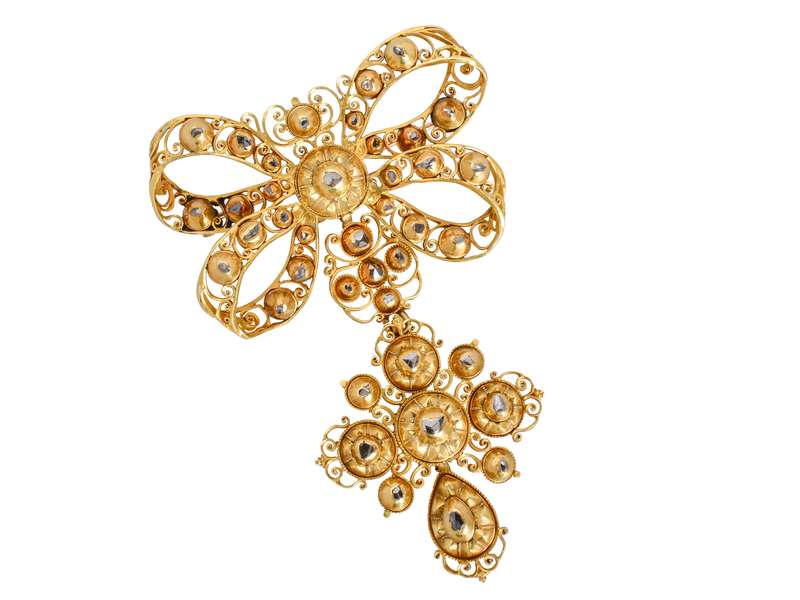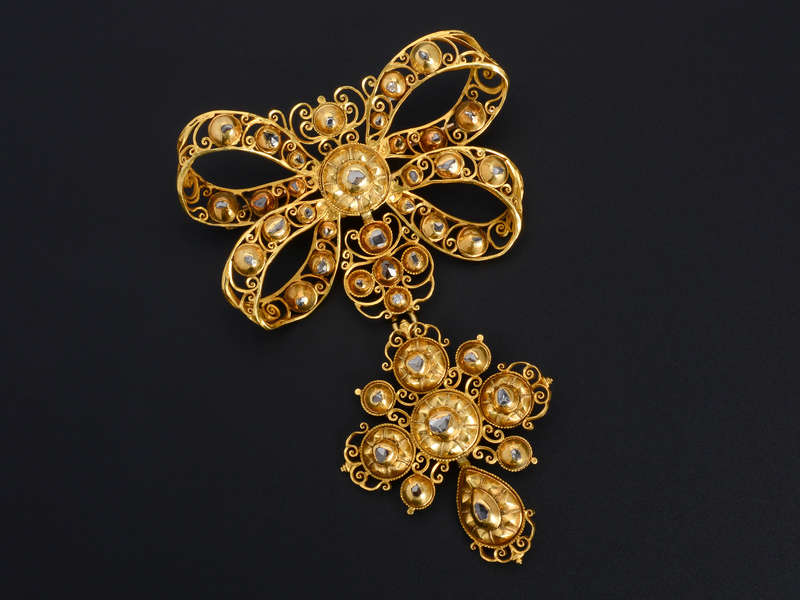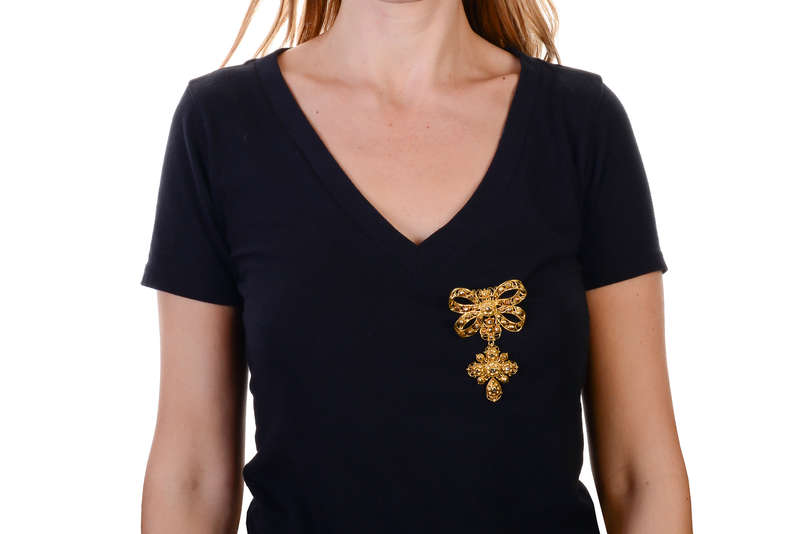
Splendid Sun - Georgian Iberian Diamond Pendant Brooch
One of the more influential designs of the century was the bow. Along with the feather, flowers and leaves, teardrops, and the girandole (three drops) - the bow design was pervasive.
Sévigné bows, were so named for a prolific 17th and early 18th century writer, Madame de Sévigné. A great friend of Louis XIV, the wearing of this bow form is credited with her name. And from this - its Iberian descendant, the œlaca� form stems as well.
Stomachers were one of the œmust haves� of the century. Gowns with elongated and flattened bodices were the ideal backdrop for trailing jewels down the breast and front. Some were worn high on the neck from a ribbon.
While this jewel was later converted to a brooch, its original type (fittings still intact) was a slide. A ribbon was threaded through the two gold tabs on the reverse, to wear at the throat. Naturally from that ribbon, a large and showy real bow was secured at the nape. It may still be worn this way.
This impressive stomacher is of the highest order of workmanship and materials. Gold of 18k is nearly woven into lace into a medley of shapes and pillows to hold the diamonds. Characteristic of the period, puffs of burnished gold hold diamonds at their apex.
Six possess-shaped tufted pillows of gold at their bases. Typical of this region, one finds numerous jewels set with these domed cushions of gold and their sections and patterns. Light plays off these curvaceous surfaces and along with the lacy spirals of gold, play an important role in the jewel™s overall appeal.
Spirals and tendrils of gold illuminate a total of 40 diamonds, both table, and rose cuts. Its delicacy of gold work allows this to be wearable by many. Light and space help define the jewel with a delicacy that seems unimaginable for its time.
Similar examples can be seen in books such as, œFive Centuries of Jewellery� of the National Museum of Ancient Art, Lisbon on page 46 and 47.
Historical Notes: Portugal™s port in Lisbon, was a gateway from Goa in India for precious gems and gold pouring in from South America. The same for Spain and its routes to the New World. Riches made their way to the old world via its trade routes. Gold, diamonds, emeralds, topazes, and other gems literally flowed in to be disseminated through Europe and Britain.
Brazil was a center for gold and diamonds and these influxes of changed jewelry design forever. Gone was the reliance on metal work and enamel. From the 17th century onward, jewelry focused on gems, their color, and their brilliance.
We have the convents of Spain and Portugal to thank for many of our examples of 17th and 18th century grandeur in jewelry. Young women of noble families, who, for various reasons were not married by a certain age, were sometimes left under the care of convents. With them came their families™ donations of lavish jewels.
These convents were disbanded in 1834 and so the jewels worked their way back into the public. Often saved from the vagaries of remounting and re-working, particularly during later wars and strife. Tradition too kept these with families for generations and some still come to light in near mint condition.
FREE WORLDWIDE!
Lightning Fast
Most purchases ship the same day if purchased by noon Eastern.
Shipping occurs M-F and arrives M-Fri or Sat by USPS.
Shipments are anonymous for surprises and gift-giving.
DOMESTIC METHODS



FREE 2-3 DAY via UPS, FedEx, or USPS.
- A physical address and phone number are required.
- IMPORTANT: A signature is required for insurance
- If missed, redelivery occurs the following day.
HOLD OPTIONS
Hold at FedEx hold locations. A photo ID of the addressee is required.
USPS hold at your local post office.
UPGRADED OPTIONS CHARGES
2 Day morning delivery. Usually by 10:30 am. $35—to major areas
Overnight—$35
Priority Overnight Usually by 10:30 am—$45
Saturday Delivery—$50
INSURANCE
GRATIS! Every package is fully insured by a specialized jewelry insurance carrier. You receive a full refund right away if lost, damaged, or stolen. Contact us immediately! Remember, after shipping thousands of packages a year since 2002, problems are very rare.
HOW IS MY JEWELRY BOXED?
A lovely hand-made Italian gift box with a fabric ribbon is provided. Please refer to this page for photographs and more information.
FREE RETURN SHIPPING
If for any reason you are not happy with your purchase, even returns are free from anywhere within the US. Visit the Returns section for details. Our apologies, but due to customs forms and regulations, international buyers pay for return shipping.
INTERNATIONAL SHIPPING


Express service fee is $75, fully insured via UPS or FedEx, 2-7 day service.*
Contact us to receive an estimate for any taxes, duties, or fees.
*Custom's clearance times vary.
FREE WORLDWIDE!
Lightning Fast
Most purchases ship the same day if purchased by noon Eastern.
Shipping occurs M-F and arrives M-Fri or Sat by USPS.
Shipments are anonymous for surprises and gift-giving.
DOMESTIC METHODS



FREE 2-3 DAY via UPS, FedEx, or USPS.
- A physical address and phone number are required.
- IMPORTANT: A signature is required for insurance
- If missed, redelivery occurs the following day.
HOLD OPTIONS
Hold at FedEx hold locations. A photo ID of the addressee is required.
USPS hold at your local post office.
UPGRADED OPTIONS CHARGES
2 Day morning delivery. Usually by 10:30 am. $35—to major areas
Overnight—$35
Priority Overnight Usually by 10:30 am—$45
Saturday Delivery—$50
INSURANCE
GRATIS! Every package is fully insured by a specialized jewelry insurance carrier. You receive a full refund right away if lost, damaged, or stolen. Contact us immediately! Remember, after shipping thousands of packages a year since 2002, problems are very rare.
HOW IS MY JEWELRY BOXED?
A lovely hand-made Italian gift box with a fabric ribbon is provided. Please refer to this page for photographs and more information.
FREE RETURN SHIPPING
If for any reason you are not happy with your purchase, even returns are free from anywhere within the US. Visit the Returns section for details. Our apologies, but due to customs forms and regulations, international buyers pay for return shipping.
INTERNATIONAL SHIPPING


Express service fee is $75, fully insured via UPS or FedEx, 2-7 day service.*
Contact us to receive an estimate for any taxes, duties, or fees.
*Custom's clearance times vary.
 Authenticity Guaranteed
Authenticity Guaranteed
 Fast Shipping
Fast Shipping
 No Question Returns
No Question Returns

Breathtaking Engagement Rings
As distinctive as you are, every engagement and wedding ring is unique and handpicked for its aesthetics, condition, and authenticity. Filigree work, cluster or halo rings, three stones, wedding sets, diamonds or fine gemstones - you will know it when you see it.
Experience The World of The Three Graces
Trust & Honesty
Testimonials
The Three Graces adds a personal touch with absolute professionalism that makes every interaction special.
I have been buying here more than a decade. An ever-changing collection that feels curated, carefully chosen, always high quality.
It never ceases to amaze me how every lovely piece of antique jewelry is so immaculate and ageless.















